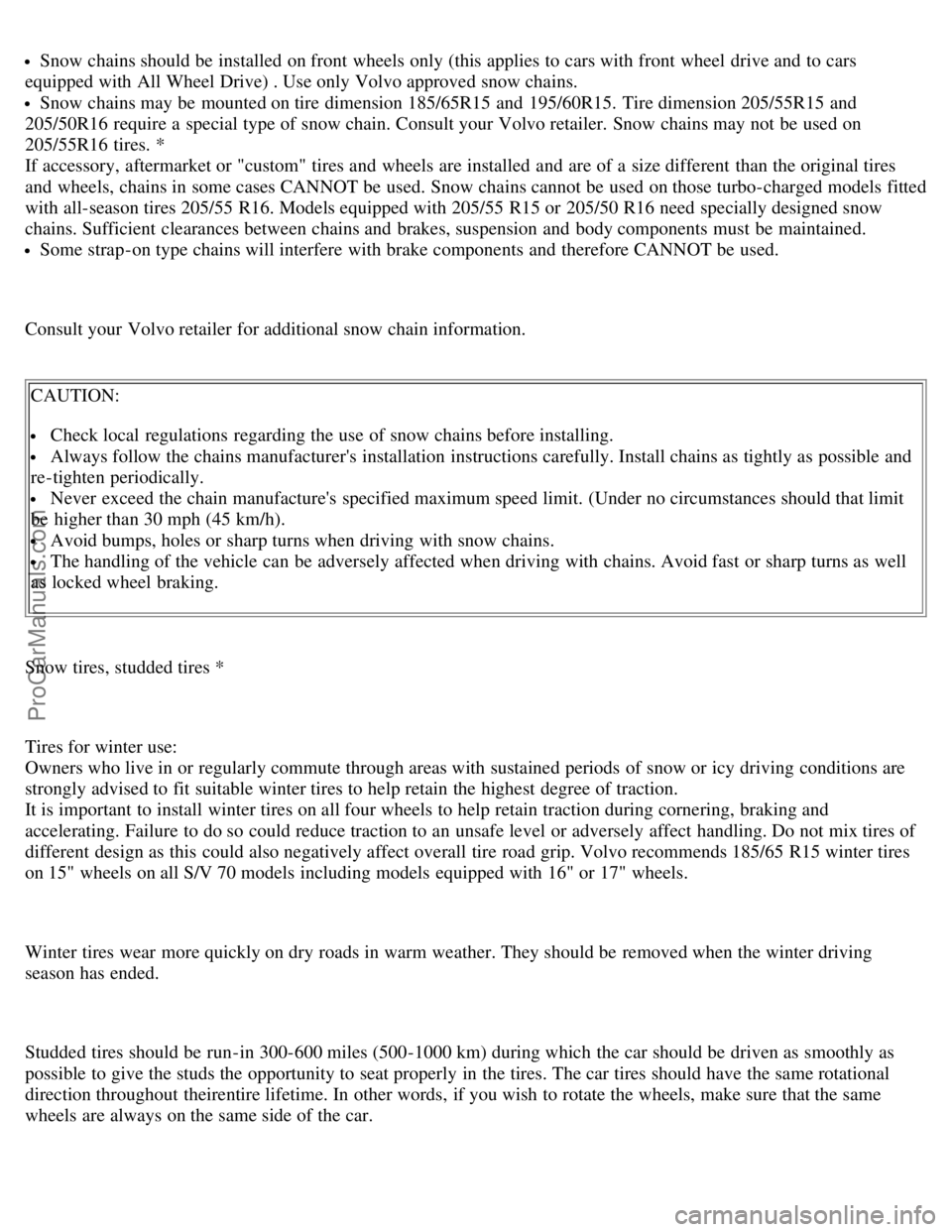Page 21 of 52
Other factors which decrease gas mileage are:
Worn or dirty spark plugs
Incorrect spark plug gap
Dirty air cleaner
Dirty engine oil and clogged oil filter
Dragging brakes
Incorrect front end alignment
Some of the above mentioned items and others are checked at the standard Maintenance Service intervals.
NOTE: ( D )rive or 5th gear (manual transmissions) should be used as often as possible to help improve fuel economy.
Contents | Top of Page
ProCarManuals.com
Page 24 of 52

Snow chains should be installed on front wheels only (this applies to cars with front wheel drive and to cars
equipped with All Wheel Drive) . Use only Volvo approved snow chains.
Snow chains may be mounted on tire dimension 185/65R15 and 195/60R15. Tire dimension 205/55R15 and
205/50R16 require a special type of snow chain. Consult your Volvo retailer. Snow chains may not be used on
205/55R16 tires. *
If accessory, aftermarket or "custom" tires and wheels are installed and are of a size different than the original tires
and wheels, chains in some cases CANNOT be used. Snow chains cannot be used on those turbo-charged models fitted
with all-season tires 205/55 R16. Models equipped with 205/55 R15 or 205/50 R16 need specially designed snow
chains. Sufficient clearances between chains and brakes, suspension and body components must be maintained.
Some strap -on type chains will interfere with brake components and therefore CANNOT be used.
Consult your Volvo retailer for additional snow chain information. CAUTION:
Check local regulations regarding the use of snow chains before installing.
Always follow the chains manufacturer's installation instructions carefully. Install chains as tightly as possible and
re-tighten periodically.
Never exceed the chain manufacture's specified maximum speed limit. (Under no circumstances should that limit
be higher than 30 mph (45 km/h).
Avoid bumps, holes or sharp turns when driving with snow chains.
The handling of the vehicle can be adversely affected when driving with chains. Avoid fast or sharp turns as well
as locked wheel braking.
Snow tires, studded tires *
Tires for winter use:
Owners who live in or regularly commute through areas with sustained periods of snow or icy driving conditions are
strongly advised to fit suitable winter tires to help retain the highest degree of traction.
It is important to install winter tires on all four wheels to help retain traction during cornering, braking and
accelerating. Failure to do so could reduce traction to an unsafe level or adversely affect handling. Do not mix tires of
different design as this could also negatively affect overall tire road grip. Volvo recommends 185/65 R15 winter tires
on 15" wheels on all S/V 70 models including models equipped with 16" or 17" wheels.
Winter tires wear more quickly on dry roads in warm weather. They should be removed when the winter driving
season has ended.
Studded tires should be run-in 300-600 miles (500-1000 km) during which the car should be driven as smoothly as
possible to give the studs the opportunity to seat properly in the tires. The car tires should have the same rotational
direction throughout theirentire lifetime. In other words, if you wish to rotate the wheels, make sure that the same
wheels are always on the same side of the car.
ProCarManuals.com
Page 40 of 52

first. See "Service Reminder indicator", page 21.
2) For services beyond 60,000 miles (96,000 km), consult your "Maintenance Records booklet".
3) These services apply to turbo-charged models and some non-turbo models, depending on actual driving conditions
(see page 125
for details).
4) For proper functioning of the vehicle and its emission control system, Volvo recommends that the timing belt be
replaced every 70,000 miles (112,000 km).
pg. 119 Maintenance schedule (cont.)
Maintenance schedule
A = Adjust (Correct if necessary) I = Inspect (Correct or Replace if necessary)
R = Replace L = Lubricate
Maintenance Operation thousand miles
(thousand km) 10
(16)20
(32)30
(48)40
(64)50
(80)60
(96)
ENGINE SYSTEM MAINTENANCE
ENGINE
Fuel (Line) Filter¹
PCV Nipple (orifice)/hoses,clean I
Battery IIIIII
BRAKES
Inspect brakes, replace components as necessary IIIIII
Brake Fluid²
STEERING/SUSPENSION
Rotate tires/check wear (align front end if needed.) IIIIII
Check power steering fluid level. IIIIII
Grease front link arm stops LLLLLL
BODY
Power antenna (clean) IIIIII
Trunk/hood, hinges and latches LLLLLL
Air cabin filter RRR
1) Replace at 100,000 miles (160,000 km)
2) Brake fluid should be changed at owner request every second year (once a year if the car is driven in mountainous
areas or in areas with high humidity).
The following items should be checked weekly by the driver (it takes only a few minutes).
Engine oil level Horns
Brake fluid level Windshield wipers
Radiator coolant level Tire pressure (all five tires)
ProCarManuals.com